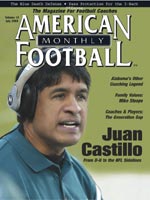Article CategoriesAFM Magazine
|
Into the VoidKent State redefines the void in zone defense© More from this issue In the early years of football an end was not overly involved
in the game. An end lined up next to a tackle and usually blocked
the man over you, blocked the man inside of you or, on occasions,
ran a post route or a corner route. Well, times continue to change
and most coaches under 40 probably don’t remember when there
weren’t wide receivers on an offense. Those of us that do
remember know that when the forward pass became a part of the game
we needed to throw the ball to an end who was in a void. The ‘Void’ being
an area between linebackers, or between linebackers and defensive
backs, or between defensive backs and the goal line. Today, the
....The full article can only be seen by subscribers.
|
|
|||||||
| HOME |
MAGAZINE |
SUBSCRIBE | ONLINE COLUMNISTS | COACHING VIDEOS |
Copyright 2025, AmericanFootballMonthly.com
All Rights Reserved





